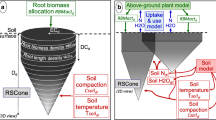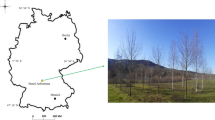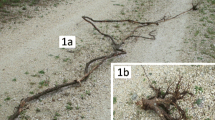Abstract
Based on fractal and pipe model assumptions, a static three-dimensional model of the Gliricidia sepium root system was developed, in order to provide a basis for the prediction of root branching, size and mass in an alley cropping system. The model was built from observations about the topology, branching rules, link length and diameter, and root orientation, provided by in situ and extracted root systems. Evaluation tests were carried out at the plant level and at the field level. These tests principally concerned coefficients α and q –- the proportionality factor α between total cross-sectional area of a root before and after branching, and allocation parameter q that defines the partitioning of biomass between the new links after a branching event –- that could be considered as key variables of this fractal approach. Although independent of root diameter, these coefficients showed a certain variability that may affect the precision of the predictions. When calibrated, however, the model provided suitable predictions of root dry matter, total root length and root diameter at the plant level. At the field level, the simulation of 2D root maps was accurate for root distribution patterns, but the number of simulated root dots was underestimated in the surface layers. Hence recommendations were made to improve the model with regard to α and q. This static approach appeared to be well suited to study the root system of adult trees. Compared with explicit models, the main advantage of the fractal approach is its plasticity and ease of use.
Similar content being viewed by others
References
Aguirrezabal L A N, Pellerin S and Tardieu F 1993 Carbon nutrition, root branching and elongation: can the present state of knowledge allow a predictive approach at the whole plant level? Environ. Exp. Bot. 33, 121–130.
Berntson G M 1996 Fractal geometry, scaling, and the description of plant root architecture. In Plant Roots. The Hidden Half. Eds Y Waisel, A Eshel and U Kafkafi, 2nd ed., rev. and expanded. pp 259–272. MDI Dekker, New York.
Bloomfield J and Vogt K 1996 Tree root turnover and senescence. In Plant Roots. The Hidden Half. Eds. Y Waisel, A Eshel and U Kafkafi, 2nd ed., rev. and expanded. pp 363–381. MDI Dekker, New York.
Box J E Jr 1996 Modern methods for root investigations. In Plant Roots. The Hidden Half. Eds. Y Waisel, A Eshel and U Kafkafi, 2nd ed., rev, and expanded. pp 193–237. MDI Dekker, New York.
Chloupek O 1977 Evaluation of the size of a plant's root system using its electrical capacitance. Plant Soil 48, 525–532.
Clausnitzer V and Hopmans J W 1994 Simultaneous modeling of transient three-dimensional root growth and soil water flow. Plant Soil 164, 299–314.
De Reffye P, Houllier F, Blaise F, Barthelemy D, Dauzat J and Auclair D 1995 A model simulating above-and below-ground tree architecture with agroforestry applications. Agroforestry Syst. 30, 161–173.
Diggle A J 1988 ROOTMAP-a model in three-dimensional coordinates of the growth and structure of fibrous root systems. Plant Soil 105, 169–178.
Eghball B, Settimi J R, Maranville J W and Parkhurst A M 1993 Fractal analysis for morphological description of corn under nitrogen stress. Agron. J. F. 85, 287–289.
Fitter A H 1986 The topology and geometry of plant root systems: influence of watering rate on root system topology in Trifolium pretense. Ann. Bot. 58, 91–101.
Fitter A H and Stickland T R 1992 Fractal characterization of root architecture. Funct. Ecol. 6, 632–635.
Huxley P 1996 Biological factors affecting form and function in woody-non-woody plant mixtures. In Tree-Crop Interactions-A Physiological Approach. Eds. C K Ong and P Huxley. pp 235–299. CAB International, Wallingford, UK.
Lynch J P and Nielsen K L 1996 Simulation of root system architecture. In Plant Roots. The Hidden Half. Eds. Y Waisel, A Eshel and U Kafkafi, 2nd ed., rev, and expanded. pp 247–257. MDI Dekker, New York.
Mäkelä A 1986 Implications of the pipe model theory on dry matter partitioning and height growth in trees. J. Theor. Biol. 123, 103–120.
Měech R and Prusinkiewicz P 1996Visual models of plants interacting with their environment. Computer Graphics proceedings, Annual Conference Series. SIGGRAPH 96, pp 397–410. New Orleans, LA, 4–9 August, 1996.
Nielsen K L, Lynch J P, Jablokow A G and Curtis P S 1994 Carbon cost of root systems: an architectural approach. Plant Soil 165, 161–169.
Ozier-Lafontaine Fl, Lafolie F, Bruckler L, Tournebize R and Mollier A 1998 Modeling competition for water in intercrops: theory and comparison with field experiments. Plant Soil, 204: 183–201.
Pagès L and Pellerin S 1996 Study of differences between vertical root maps observed in a maize crop and simulated maps obtained using a model for the three-dimensional architecture of the root system. Plant Soil 182, 329–337.
Pagès L, Jordan M O and Picard D 1989 A simulation model of the three-dimensional architecture of the maize root system. Plant Soil 119, 147–154.
Parrotta J A and Singh I P 1992 Gliricidia sepium root system morphology and biomass allocation. Nitrogen Fixing Trees Res. Rep. 10, 169–172.
Pertunen J, Sievänen R, Nikinmaa E, Salminens H, Saarenmaa H and Väkevä J 1996 LIGNUM: a tree model based on simple structural units. Ann. Dot. 77, 87–98.
Rao M R, Muraya P and Huxley P A 1993 Observations of some tree root systems in agroforestry intercrop situations, and their graphical representation. Exp. Agric. 29, 183–194.
Rose D A 1983 The description of the growth of root systems. Plant Soil 75, 405–415.
Sapoval 1997 Universalités et fractales. Jeux d'enfants ou délits d'initiés? N.B.S. Flammarion, France.
Shibusawa S 1994 Modelling the branching growth fractal pattern of the maize root system. Plant Soil 165, 339–347.
Shinosaki K, Yoda K, Hozumi K and Kira T 1964 A quantitative analysis of plant form-the pipe model theory. I. Basic analysis. Jpn. Ecol. l4, 97–132.
Spek L Y and Van Noordwijk M 1994 Proximal root diameter as predictor of total root size for fractal branching models. II. Numerical model. Plant Soil 164, 119–127.
S-Plus 1991 S-Plus User's Manual. Statistical Sciences, Inc., Seattle, WA.
Tatsumi J, Yamauchi A and Kono Y 1989 Fractal analysis of plant root systems. Ann. Bot. 64, 499–503.
Thaler P and Pagès L 1996 Root apical diameter and root elongation rate of rubber seedlings (Hevea brasiliensis) show parallel responses to photoassimilate availability. Physiol. Plant. 97, 365–371.
Van Beem J, Smith M F and Zobel R W 1998 Estimating root mass in maize using a portable capacitance meter. Agron. J. 90, 566–570.
Van Noordwijk M and Purnosidhi P 1995 Root architecture in relation to tree-soil-crop interactions and shoot pruning in agroforestry. Agroforestry Syst. 30, 161–173.
Van Noordwijk M, Spek L Y and De Willingen P 1994 Proximal root diameter as predictor of total root size for fractal branching models. I. Theory. Plant Soil 164, 107–117.
Van Noordwijk M and Van de Geijn S C 1996 Root, shoot and soil parameters required for process-oriented models of crop growth limited by water or nutrients. Plant Soil 183, 1–25.
West B J, Brown J H and Enquist B J 1997 A general model for the origin of allometric scaling laws in biology. Science 276, 122–126.
William N 1997. Fractal geometry gets the measure of life's scales. Science 276, 34.
Author information
Authors and Affiliations
Rights and permissions
About this article
Cite this article
Ozier-Lafontaine, H., Lecompte, F. & Sillon, J.F. Fractal analysis of the root architecture of Gliricidia sepium for the spatial prediction of root branching, size and mass: model development and evaluation in agroforestry. Plant and Soil 209, 167–179 (1999). https://doi.org/10.1023/A:1004461130561
Issue Date:
DOI: https://doi.org/10.1023/A:1004461130561




